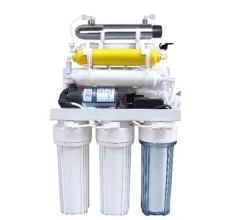The Science Behind UV-C Light Filters and Their Role in Air Purification
2024-09-29
In today's world, air quality is a top priority for both personal health and public safety. One of the most effective technologies for improving indoor air quality is UV-C light filtration. But what exactly are UV-C light filters, and how do they work to purify the air? In this blog, we’ll dive into the science behind UV-C light filters and explore why they are becoming a popular solution for cleaner, safer environments.
What is UV-C Light?
Ultraviolet (UV) light is divided into three categories: UV-A, UV-B, and UV-C. UV-C light has the shortest wavelength and is the most powerful when it comes to disinfecting and eliminating harmful microorganisms. The wavelength of UV-C light typically ranges from 200 to 280 nanometers, making it ideal for breaking down the DNA and RNA of pathogens like bacteria, viruses, and mold spores.
How UV-C Light Filters Work
UV-C light filters are designed to use this powerful wavelength to disinfect air by neutralizing harmful airborne particles. Here's how they work:
1. Air Intake: The filter system pulls in air from the surrounding environment.
2. UV-C Light Exposure: As the air passes through the filtration system, it is exposed to UV-C light. The ultraviolet light disrupts the genetic material of pathogens, rendering them inactive or unable to reproduce.
3. Filtered Air Output: After passing through the UV-C chamber, the air is free of many harmful microorganisms and allergens, and is then circulated back into the room.
UV-C light filters are especially effective in environments where air quality is crucial, such as hospitals, clinics, and public spaces. They can significantly reduce the risk of airborne diseases and improve overall air purity.
Key Benefits of UV-C Light Filters
1. Effective Against Airborne Pathogens
UV-C light has been scientifically proven to neutralize a wide range of microorganisms, including bacteria, viruses, and fungi. Studies have shown that UV-C light can kill up to 99.9% of harmful airborne particles, making it a reliable option for environments where health and safety are a concern.
2. Chemical-Free Disinfection
Unlike some traditional air purification methods that use chemicals or ozone, UV-C light filters offer a clean, chemical-free approach. They do not release harmful byproducts into the air, ensuring that the air remains safe for people and pets to breathe.
3. Energy Efficient
UV-C light filters are also known for being energy efficient. Many systems are designed to operate with minimal power consumption, making them an eco-friendly option for continuous air purification.
4. Reduced Allergens
For people who suffer from allergies, UV-C light filters can provide significant relief by reducing airborne allergens like mold spores, dust mites, and pet dander. These filters help create a cleaner, more comfortable living environment, especially for individuals with respiratory issues.
Applications of UV-C Light Filters
1. Healthcare Facilities
Hospitals and medical clinics frequently use UV-C light filters to disinfect the air in critical areas, such as operating rooms and patient wards. These systems help reduce the risk of hospital-acquired infections (HAIs) by eliminating airborne pathogens.
2. Offices and Commercial Spaces
In offices, UV-C light filters can improve air quality by reducing the spread of common illnesses like colds and flu. Clean air also promotes better concentration and productivity, leading to healthier work environments.
3. Home Use
Homeowners can also benefit from installing UV-C light filters in HVAC systems or standalone units. These filters help reduce indoor pollution, providing families with fresher, healthier air.
Conclusion
UV-C light filters are a powerful tool in the fight against airborne pathogens and pollutants. By using the natural disinfecting power of ultraviolet light, these systems can help create healthier indoor environments, whether at home, in the office, or in medical facilities. As air quality becomes an increasing concern, UV-C light filters offer a reliable, eco-friendly, and effective solution for cleaner air.



